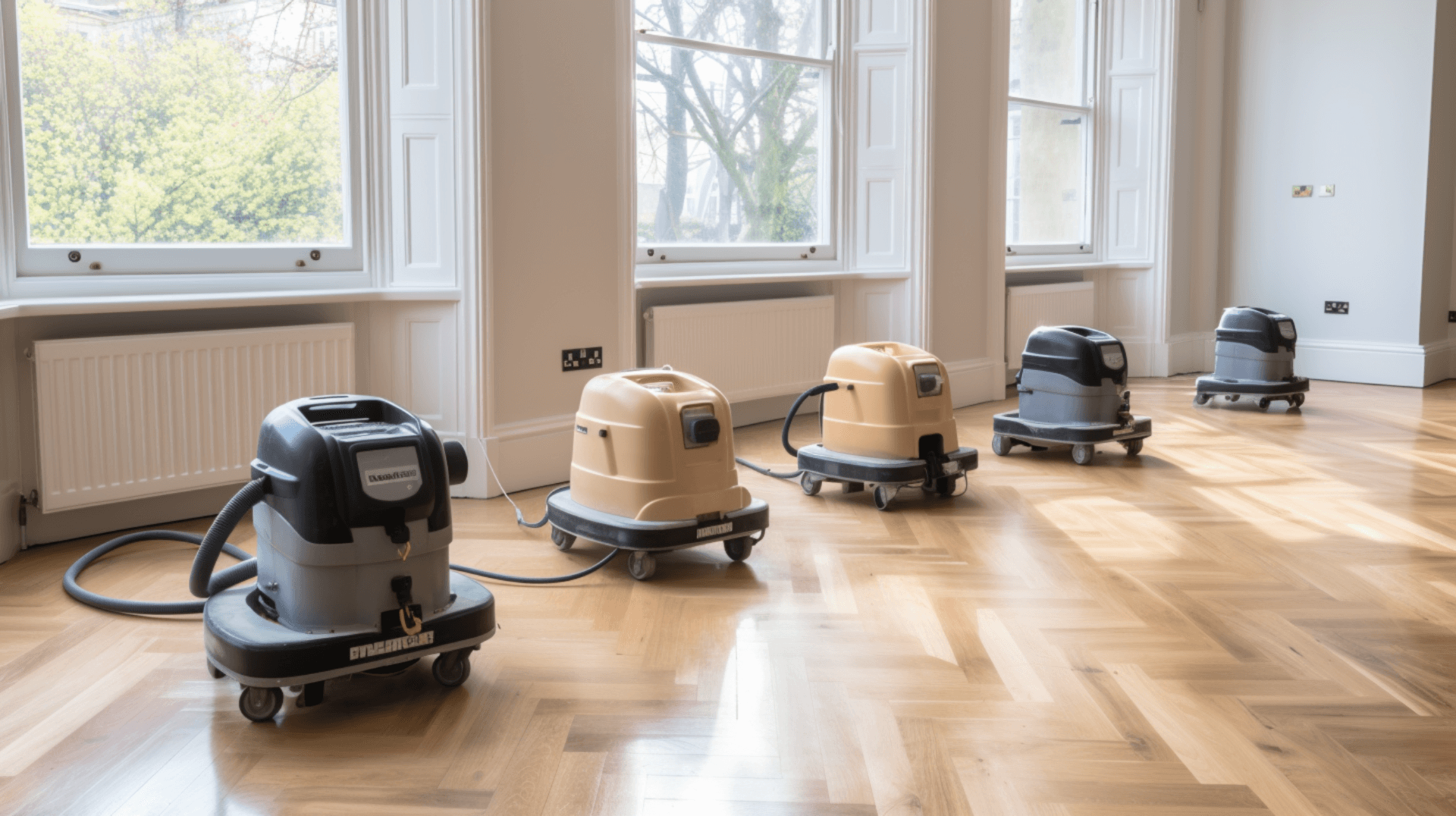Understanding the Basics of Wooden Floor Sanding Services in London
Wooden floor sanding is the process of removing the top layer of a wooden floor to restore its original appearance and condition. It is an important part of maintaining a wooden floor, as it helps to protect the wood from damage and wear, reduce the amount of dust and dirt that accumulates on the floor, and reduce the amount of noise that is generated by the floor.
Wooden floor sanding can provide a number of benefits for homeowners and business owners. It can help to restore the original beauty of a wooden floor, as well as improve its durability and longevity. Additionally, correctly insulating suspended timber floors can address both heat loss and draughts, resulting in significant benefits for carbon reduction and alleviation of fuel poverty.
In London, there are a variety of wooden floor sanding services available. These include full sanding and refinishing, spot sanding and refinishing, and repairs. Full sanding and refinishing involves removing the top layer of the floor and replacing it with a new finish. Spot sanding and refinishing involves sanding and refinishing only the areas that are damaged or worn. Repairs can include filling gaps, fixing loose boards, and addressing any other issues that may be present on the floor.
The Importance of Preparing Your Wooden Floor for Sanding

Preparing a wooden floor for sanding is an important step in the process to ensure a successful and efficient sanding job. There are several steps that should be taken to prepare a wooden floor for sanding:
- Clean the floor: Vacuum the floor thoroughly to remove any dirt, dust, and debris. Use a damp mop with an approved floor cleaner to remove any stubborn dirt or stains.
- Check for nails and staples: Inspect the floor for any nails or staples that may have been left behind. These should be removed or hammered down to prevent damage to the sanding machine.
- Fill gaps and cracks: Fill any gaps or cracks in the floor with a wood filler to ensure a smooth and even surface.
To protect other parts of your house from dust and vapors during the sanding process, it is important to take the following precautions:
- Seal off the area: Use plastic sheeting to seal off the area where the sanding will take place. This will help contain the dust and vapors and prevent them from spreading to other parts of the house.
- Close windows and doors: Ensure that all windows and doors are closed to prevent dust and vapors from entering the house.
When sanding a wooden floor, it is important to take precautions to protect HVAC systems. This can be done by turning off the HVAC system and sealing off the vents with plastic sheeting.
By following these steps and taking the necessary precautions, you can ensure that your wooden floor is properly prepared for sanding and that other parts of your house are protected during the process.
Selecting the Right Grit Sequence for Your Wooden Floor Sanding
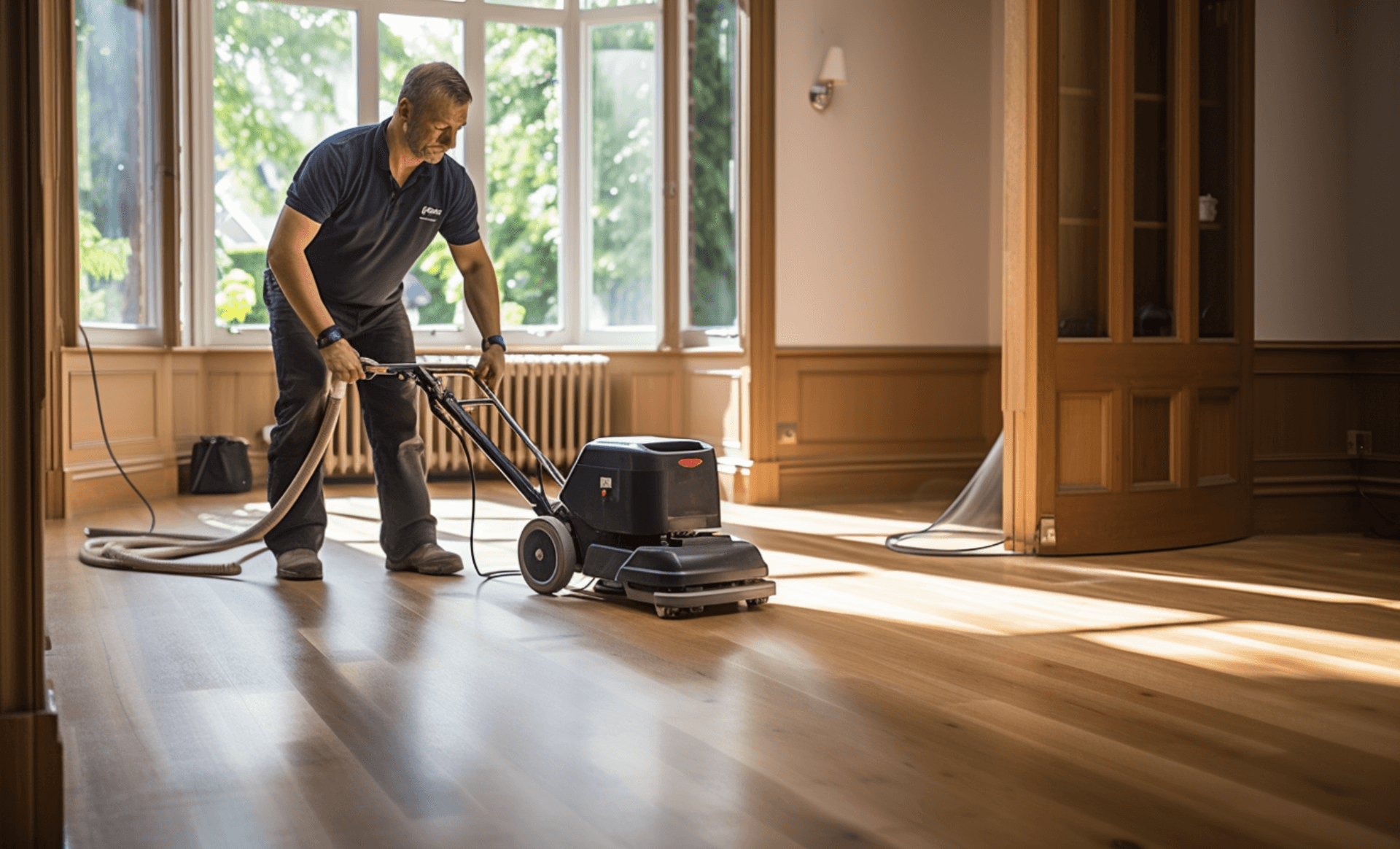
Selecting the right grit sequence for your wooden floor sanding is essential for achieving the desired outcome. The recommended grit sequence for wooden floor sanding is to start with a coarse grit, such as 40-60 grit, and then progress to a medium grit, such as 80-100 grit, and finally finish with a fine grit, such as 120-150 grit. This sequence ensures that the floor is properly sanded and that the finish is even and smooth.
Skipping more than one grit of abrasive in the sanding sequence can have a negative impact on the outcome of the sanding process. If the floor is not sanded with the correct sequence, it can result in an uneven finish and the floor may not be properly prepared for the next step in the process. Additionally, skipping grits can cause the floor to be over-sanded, resulting in a loss of wood and a decrease in the life of the floor.
Using the correct grit sequence is crucial for the outcome of the sanding process. The sequence ensures that the floor is properly sanded and that the finish is even and smooth. Additionally, it helps to protect the wood from damage and wear, reduce the amount of dust and dirt that accumulates on the floor, and reduce the amount of noise that is generated by the floor.
By following the recommended grit sequence and taking the necessary precautions, such as using fabric-faced abrasive pads to prevent damage, you can ensure that your wooden floor is properly sanded and finished, resulting in a beautiful and long-lasting outcome.
Exploring Different Types of Finishes for Your Sanded Wooden Floor

Exploring Different Types of Finishes for Your Sanded Wooden Floor
When it comes to wooden floor finishes, there are a variety of options available to suit different needs and preferences. The most common types of finishes are oil, wax, lacquer, and polyurethane. Each type of finish has its own unique properties, advantages, and disadvantages.
- Oil Finishes: Oil finishes provide a natural, low-sheen look to the floor. They enhance the natural beauty of the wood and are easy to apply. Oil finishes penetrate the wood, providing a protective layer that helps to prevent scratches and scuffs. oil finishes require regular maintenance and may need to be reapplied more frequently compared to other finishes.
- Wax Finishes: Wax finishes offer a soft, low-sheen look to the floor. They provide a protective layer that helps to prevent scratches and scuffs. Wax finishes are easy to apply and maintain. they may require more frequent reapplication and can be more challenging to remove compared to other finishes.
- Lacquer Finishes: Lacquer finishes provide a glossy, high-sheen look to the floor. They are highly durable and resistant to scratches and scuffs. Lacquer finishes are easy to apply and provide a hard protective layer. they can be more difficult to repair and may require professional assistance.
- Polyurethane Finishes: Polyurethane finishes offer a glossy, high-sheen look to the floor. They are extremely durable and provide excellent protection against scratches and scuffs. Polyurethane finishes are easy to apply and maintain. they can be more expensive compared to other finishes.
Choosing the right finish for your sanded wooden floor depends on your desired look, level of maintenance, and durability requirements. Oil and wax finishes are great for those who prefer a natural, low-sheen look, while lacquer and polyurethane finishes are ideal for those who want a glossy, high-sheen finish. Consider the specific properties and maintenance requirements of each finish to make an informed decision that will enhance the look and longevity of your wooden floor.
The Process of Wooden Floor Sanding: A StepbyStep Guide
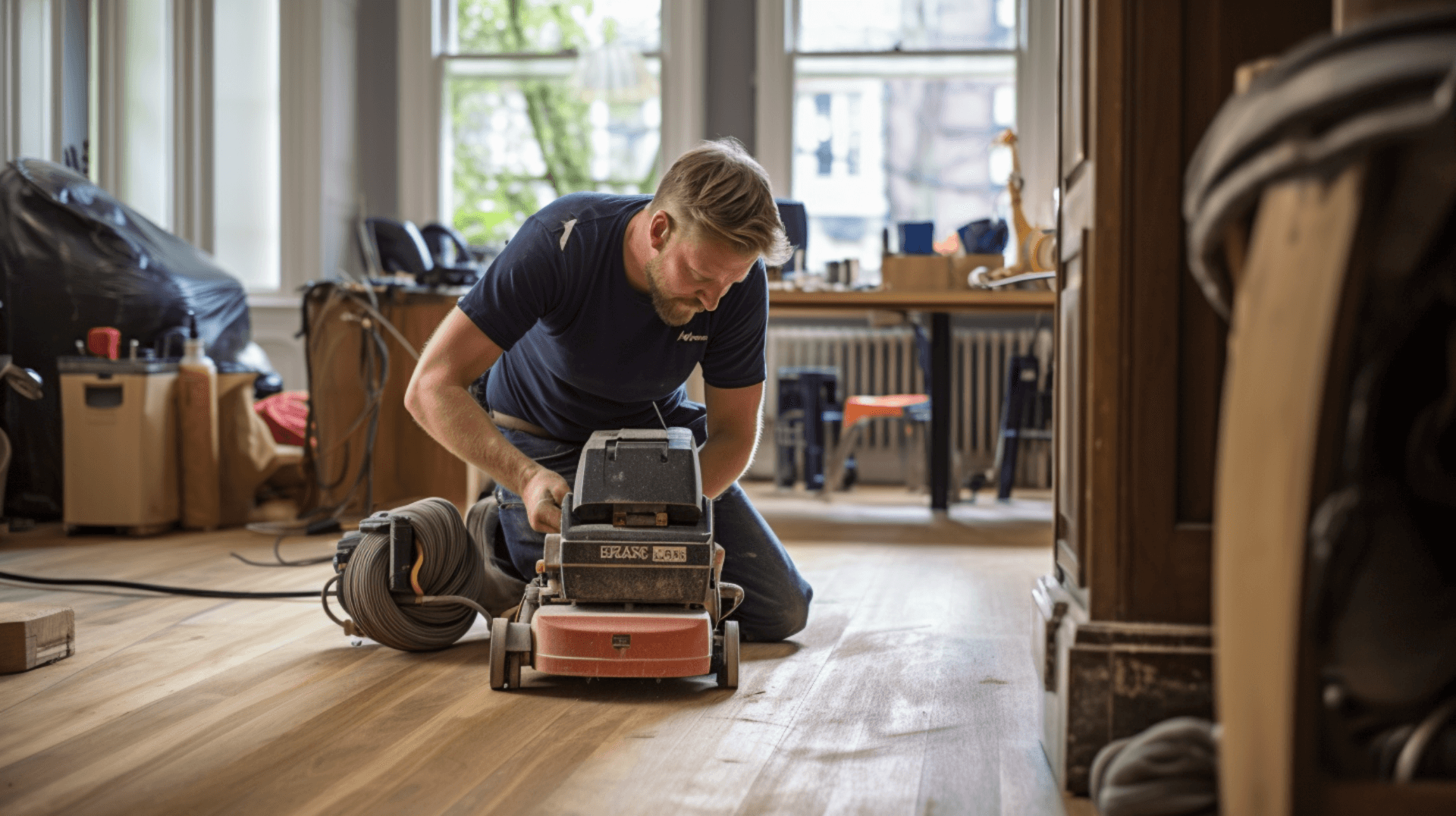
Wooden floor sanding is the process of removing the top layer of a wooden floor to restore its original appearance and condition. It is an important part of maintaining a wooden floor, as it helps to protect the wood from damage and wear, reduce the amount of dust and dirt that accumulates on the floor, and reduce the amount of noise that is generated by the floor.
The process of wooden floor sanding involves several steps, including preparation, sanding, and finishing.
Preparation
Before sanding, it is important to prepare the floor. This includes vacuuming the floor to remove any dirt, dust, and debris, and using a damp mop with an approved floor cleaner to remove any stubborn dirt or stains. It is also important to check for nails and staples, and fill any gaps or cracks in the floor with a wood filler to ensure a smooth and even surface. Additionally, it is important to take safety precautions to protect other parts of the house from dust and vapors during the sanding process, such as sealing off the area with plastic sheeting and closing windows and doors. To protect HVAC systems, it is important to turn off the HVAC system and seal off the vents with plastic sheeting.
Sanding
The sanding process involves using a drum sander or belt sander for larger areas of the floor and an edger sander for edges and corners. It is recommended to start with a coarse grit, such as 40-60 grit, to remove the top layer of the floor and any imperfections. Progress to a medium grit, such as 80-100 grit, to further smooth the floor. Finally, finish with a fine grit, such as 120-150 grit, to achieve a smooth and even surface.
Finishing
After sanding, it is important to apply a finish to protect the wood and enhance its appearance. There are various finishes available, such as oil, wax, lacquer, or polyurethane. Choose a finish that suits your preferences and follow the manufacturer’s instructions for application.
During the sanding process, it is crucial to take safety precautions to protect yourself and your surroundings. Wear respiratory protection, such as a filter class P2 mask, to prevent inhalation of dust. Remove the dust bag from the sanding machine and empty it outdoors into a non-flammable container. Ensure proper electrical connections and follow the manufacturer’s warnings and operational instructions. Dispose of the dust safely to prevent combustion.
By following these steps and taking the necessary safety precautions, you can achieve a beautifully restored wooden floor that is protected and durable.
Understanding the Role of Sanding Machines in Wooden Floor Restoration
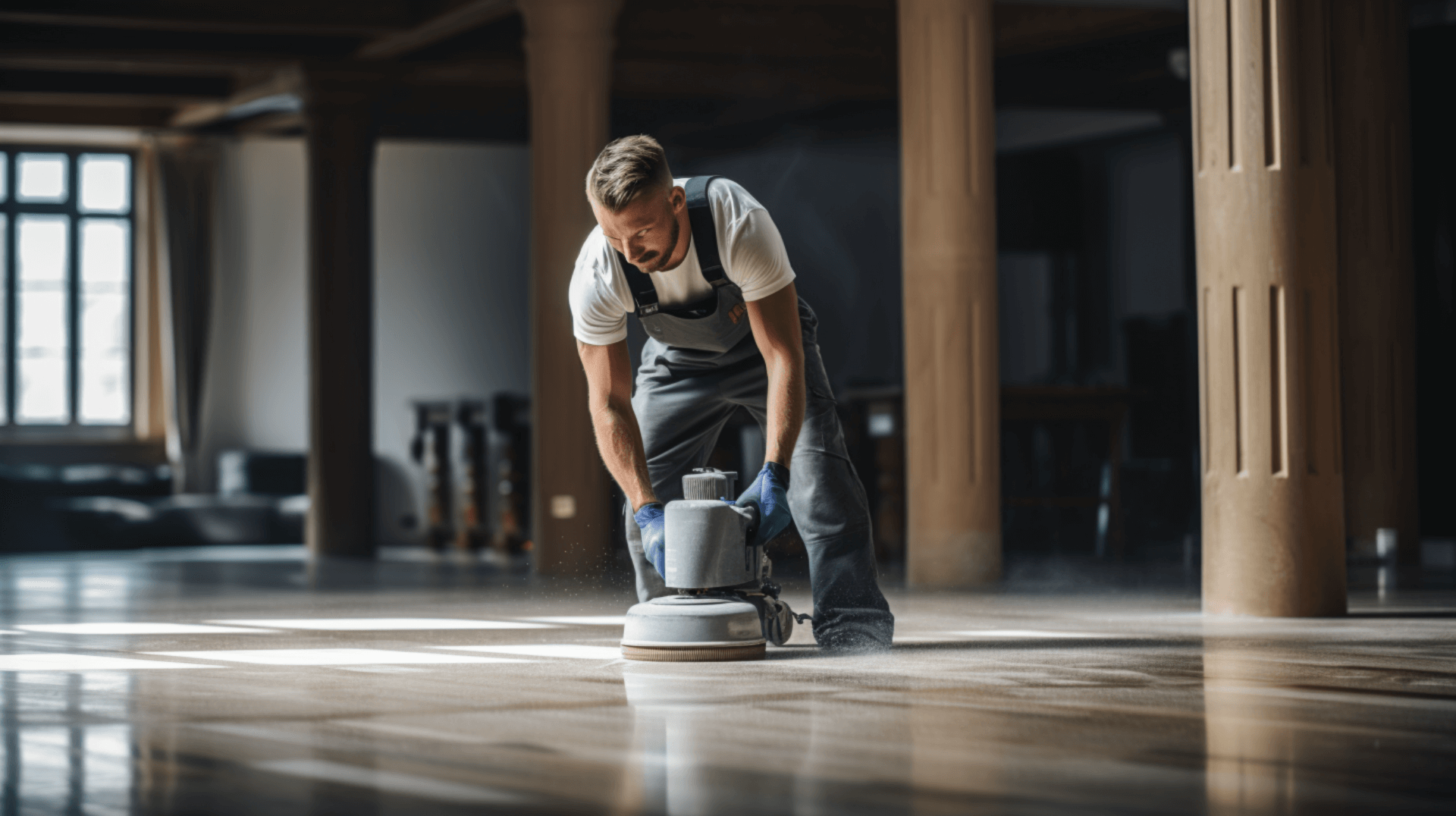
Understanding the Role of Sanding Machines in Wooden Floor Restoration
Sanding machines play a crucial role in the restoration of wooden floors, as they are designed to remove the top layer of the floor and prepare it for refinishing. There are several types of sanding machines used in wooden floor restoration, each with its own advantages and disadvantages.
Drum Sanders: Drum sanders are the most powerful type of sanding machine and are ideal for large areas of flooring. They are designed to remove the top layer of the floor quickly and efficiently. The main advantage of drum sanders is their speed and power, which allows for fast and effective sanding. they can be difficult to control and can cause damage to the floor if not used correctly. It is important to use a dust collection system with a drum sander, such as a filter class P2 mask, to prevent inhalation of dust. Additionally, the dust bag should be removed from the sanding machine and emptied outdoors into a non-flammable container.
Belt Sanders: Belt sanders are similar to drum sanders but are slightly less powerful. They are ideal for larger areas of flooring and can be used to remove the top layer of the floor quickly and efficiently. The main advantage of belt sanders is their speed and power, but they can be difficult to control and can cause damage to the floor if not used correctly. It is important to use a dust collection system with a belt sander to prevent inhalation of dust.
Edger Sanders: Edger sanders are designed for smaller areas of flooring and are ideal for edges and corners. They are less powerful than drum and belt sanders but are easier to control and can be used to achieve a smooth and even finish. The main advantage of edger sanders is their maneuverability and precision in tight spaces. they may require more time and effort to achieve a smooth finish compared to drum and belt sanders.
The choice of sanding machine can have a significant impact on the final result of the wooden floor restoration. Drum sanders are best suited for large areas where speed and power are important, but they require skill to control and can cause damage if not used correctly. Belt sanders offer a balance of speed and control, making them suitable for larger areas. Edger sanders are ideal for sanding edges and corners, providing maneuverability and precision in tight spaces. By selecting the appropriate sanding machine for the specific needs of the project, homeowners and business owners can ensure a successful and efficient restoration of their wooden floors.
The Importance of Subfloor Preparation in Wooden Floor Sanding
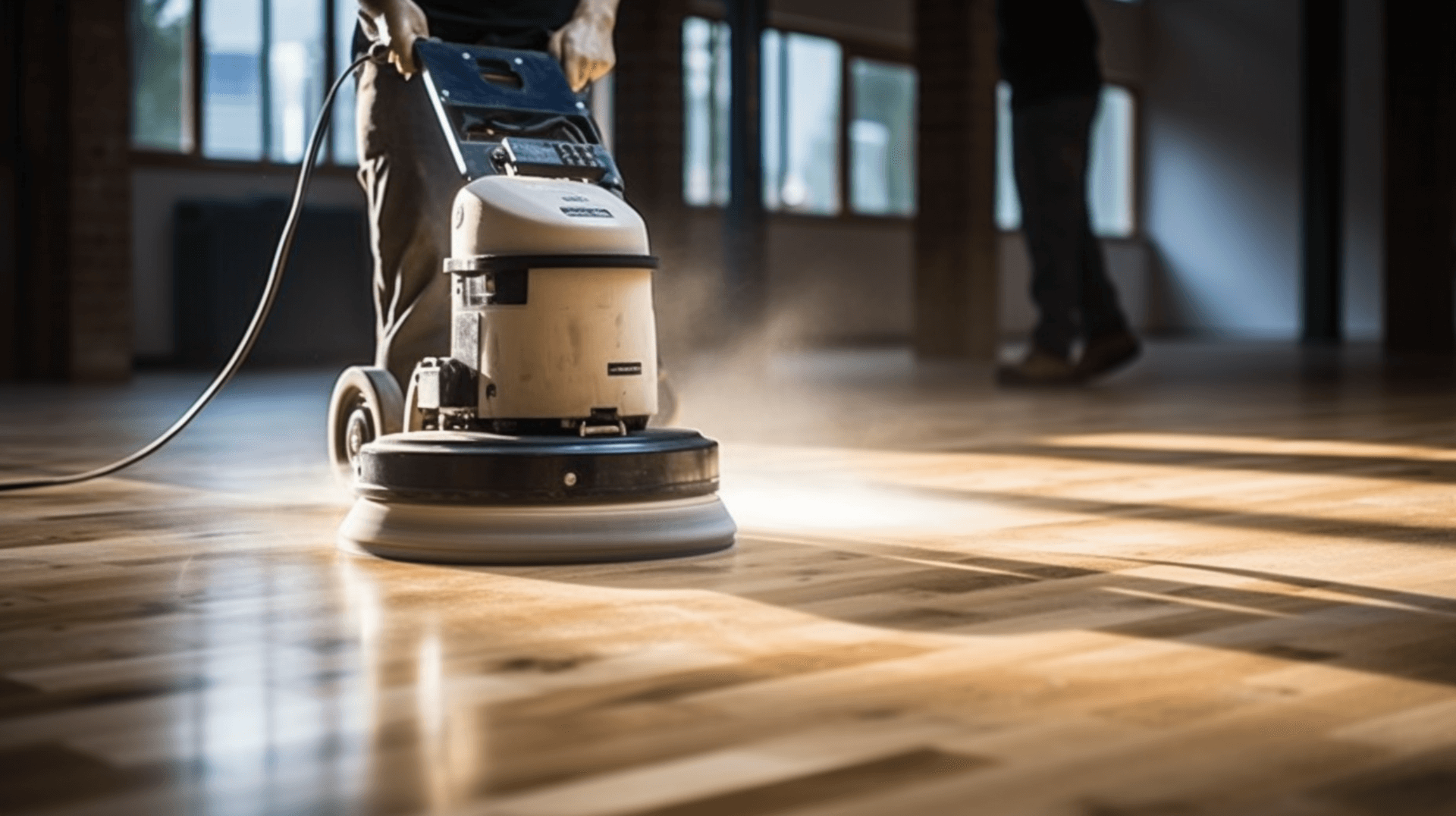
Proper subfloor preparation is essential for achieving a successful wooden floor sanding project. Before sanding a wooden floor, there are several requirements for the subfloor that need to be met. These requirements include ensuring that the subfloor is level, clean, and free of debris. Any unevenness in the subfloor should be addressed by using a self-leveling compound or a leveling compound to create a smooth and even surface. Additionally, any gaps or cracks in the subfloor should be filled with a wood filler to prevent them from being visible after sanding.
Proper subfloor preparation contributes to the success of the sanding process in several ways. it provides a smooth and even surface for the sanding machine to work on, ensuring that the sanding process is efficient and effective. This helps to achieve a consistent and high-quality finish on the wooden floor. subfloor preparation helps to prevent any issues that may arise from inadequate preparation. For example, if the subfloor is not level, it can result in an uneven sanding job and an uneven finished floor. Similarly, if the subfloor is not clean and free of debris, it can cause the sanding machine to become clogged or damaged, leading to a less effective sanding process.
Inadequate subfloor preparation can lead to several potential issues. If the subfloor is not level, it can result in an uneven sanding job, with some areas of the floor being sanded more than others. This can create an uneven finished floor that is visually unappealing. Additionally, if the subfloor is not clean and free of debris, it can cause the sanding machine to become clogged or damaged, leading to a less effective sanding process. This can result in a floor that is not properly sanded and prepared for the next steps in the process, such as staining or finishing.
Overall, proper subfloor preparation is crucial for achieving a successful wooden floor sanding project. By ensuring that the subfloor is level, clean, and free of debris, homeowners and business owners can ensure that the sanding process is efficient and effective, resulting in a high-quality finished floor. It is also important to consider any additional requirements or considerations specific to the subfloor, such as addressing electrical cables, recessed lighting, and ventilation gaps, to ensure a safe and compliant sanding process.
The Role of Professional Wooden Floor Sanding Services in Maintaining Your Floor’s Quality

Professional wooden floor sanding services like GJP Floor Sanding offer a range of benefits for home and business owners. With years of experience and expertise, GJP Floor Sanding can provide a comprehensive service that ensures the longevity and aesthetics of your wooden floor. We use the latest sanding technology and techniques, including the use of high-quality materials like polyisocyanurate (PIR), to ensure a high-quality finish that will last for years to come.
GJP Floor Sanding also offers a range of additional services, such as staining and finishing, to ensure your wooden floor looks its best. Our experienced team can provide advice and guidance on the best products and finishes to use for your floor, ensuring that it is protected and maintained to the highest standard. We can also provide advice on spot-cleaning stubborn stains and offer tips on how to keep your wooden floor in optimal condition.
What sets GJP Floor Sanding apart from other wooden floor sanding services in London is our commitment to customer service. We offer a friendly and professional service, with a team of experienced and knowledgeable staff who are always on hand to answer any questions or queries. We also offer competitive prices and a range of payment options, making it easy and convenient for customers to get the services we need.
In addition to our sanding and finishing services, GJP Floor Sanding provides subfloor preparation to ensure that the sanding process is efficient and effective, resulting in a high-quality finished floor. We can address any unevenness in the subfloor, fill gaps or cracks, and ensure that the subfloor is clean and free of debris. This level of preparation is crucial for achieving a smooth and even surface, as well as preventing any issues that may arise from inadequate preparation.
Overall, GJP Floor Sanding offers a comprehensive service that goes beyond just sanding. Our expertise, additional services, and commitment to customer satisfaction make us a reliable choice for all your wooden floor sanding needs.
Factors to Consider When Choosing a Wooden Floor Sanding Service

Factors to Consider When Choosing a Wooden Floor Sanding Service
When choosing a wooden floor sanding service, there are several factors that home and business owners should consider to ensure they make the right choice. These factors include:
- Experience and Knowledge: It is important to choose a service provider who has experience and knowledge in the field of wooden floor sanding. This ensures that they have the expertise to handle the job effectively and deliver high-quality results. Ask about their experience in the field and any customer testimonials they may have.
- Technology and Techniques: Look for a service provider who uses the latest sanding technology and techniques. This includes the use of advanced equipment like the HUMMEL belt sanding machine and high-quality materials like polyisocyanurate (PIR). These technologies and techniques ensure a superior finish that will last for years to come.
- Range of Services: Consider the range of services offered by the service provider. In addition to sanding and finishing, we should be able to provide advice on the best products and finishes to use for your floor. We should also offer additional services like spot-cleaning stubborn stains and providing tips on how to maintain your wooden floor.
- Qualifications and Certifications: Ask about the service provider’s qualifications and certifications. This ensures that they have the necessary skills and knowledge to perform the job to a high standard. Inquire about the materials they use for insulation and whether they are certified and suitable for use as UFI, and if they comply with the relevant national building regulations.
- References and Reviews: Request references and read reviews from previous customers. This will give you an idea of the service provider’s reputation and the quality of their work.
Questions to Ask a Potential Service Provider
When speaking to a potential service provider, it is important to ask them the following questions:
- What type of sanding machines do you use?
- What type of finishes do you offer?
- What additional services do you provide?
- How many years of experience do you have?
- Do you have any qualifications or certifications?
- Can you provide references from previous customers?
What Should be Included in a Wooden Floor Sanding Service Contract
When signing a contract with a wooden floor sanding service, ensure that the following details are clearly outlined:
- Type of sanding machines and finishes to be used.
- Cost of the service, including any additional charges.
- Timeline for completion.
- Any additional services required, such as staining or finishing.
- Payment terms and options.
- Warranty or guarantee for the work performed.
By considering these factors, asking the right questions, and ensuring that all details are included in the contract, home and business owners can make an informed decision and choose a reliable and professional wooden floor sanding service.
The Cost of Wooden Floor Sanding Services: What to Expect

The cost of wooden floor sanding services can vary depending on factors such as the size of the floor, the type of floor, the condition of the floor, and the type of finish required. In London, professional wooden floor sanding services typically range from 500 to 2,000. Smaller rooms like bedrooms may cost around 500-700, while larger rooms like living rooms may cost around 1,000-2,000.
GJP Floor Sanding provides value for your investment by offering a comprehensive service that goes beyond just sanding. Our experienced team can provide advice and guidance on the best products and finishes to use for your floor, ensuring that it is protected and maintained to the highest standard. We also use the latest sanding technology and techniques, ensuring efficient and effective results. Additionally, GJP Floor Sanding can address any additional requirements, such as the installation of UFI (Under Floor Insulation), which may require additional preparation and adjustments to maintain the original ventilation rate.
Overall, the cost of wooden floor sanding services can vary depending on various factors, but GJP Floor Sanding offers competitive prices and a range of services to ensure that you get the best value for your investment.
Insights from GJP Floor Sanding Experts
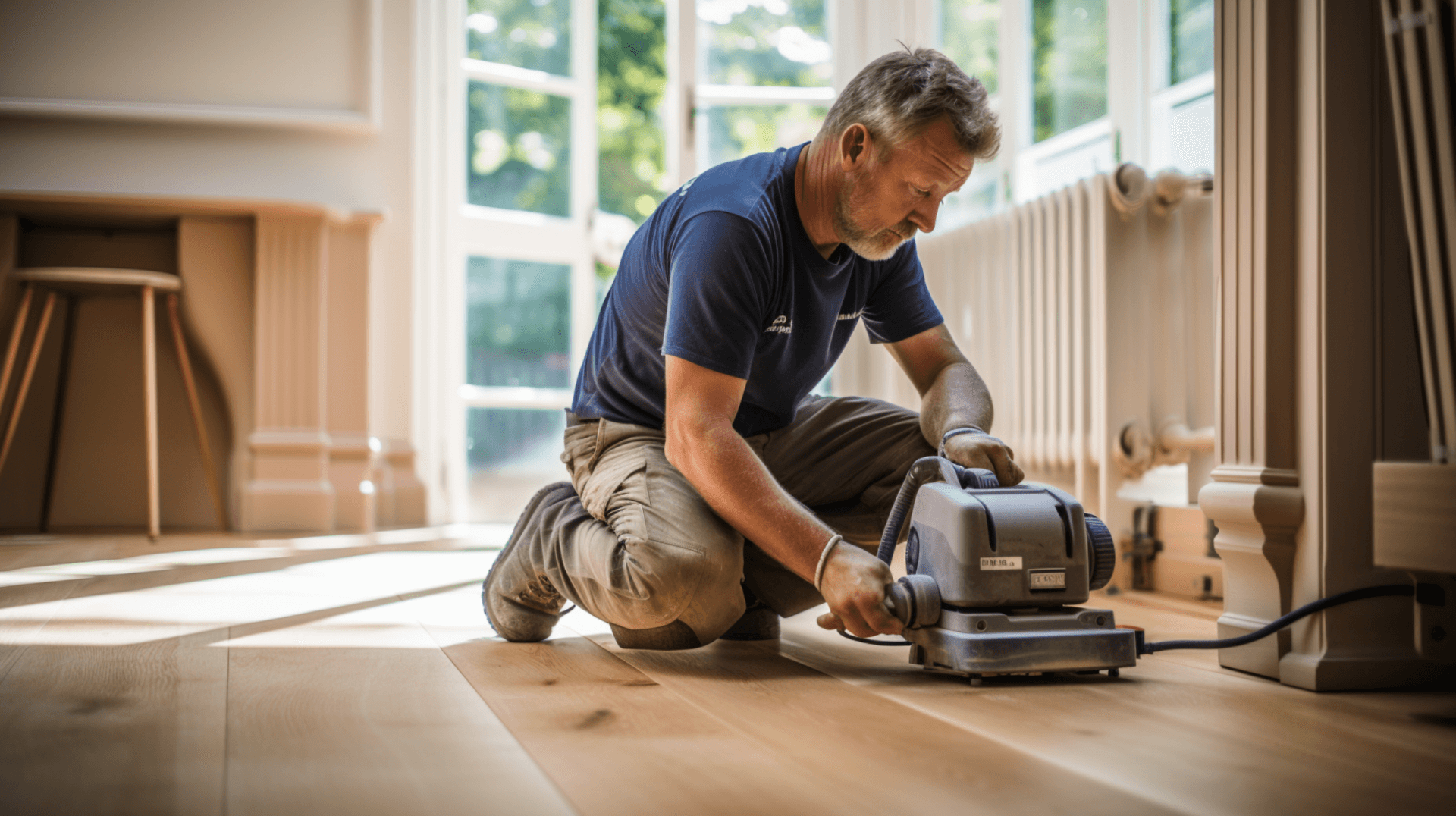
Insights from GJP Floor Sanding Experts
GJP Floor Sanding experts offer a range of tips and advice for maintaining your wooden floor. we recommend regular cleaning and vacuuming to remove dirt and dust, as this will help to keep the floor looking its best. Additionally, we suggest using a damp mop to clean the floor, as this will help to prevent scratches and damage.
Regular professional sanding can also help to improve the lifespan of your wooden floor. This is because sanding helps to remove any scratches or damage that may have occurred over time, as well as any dirt and dust that has built up. Professional sanding also helps to restore the original finish of the floor, making it look as good as new.
Underfloor insulation is also an important factor to consider when maintaining a wooden floor. Installing underfloor insulation correctly can help to reduce heat loss through the floor and eliminate draughts. Additionally, air from the outside should be able to flow under suspended timber floors, and this can be achieved through air bricks or grilles in the outer walls. This helps to maintain a healthy environment for the timber floor construction and prevent air infiltration into the habitable areas.
One of the most common misconceptions about wooden floor sanding is that it is a difficult and time-consuming process. GJP Floor Sanding experts can provide a comprehensive service that is efficient and effective, ensuring that the job is completed quickly and to a high standard. We use the latest sanding technology and techniques, making the process more efficient and reducing the time required for sanding.
By following these tips and advice from GJP Floor Sanding experts, home and business owners can ensure that our wooden floors are well-maintained and protected, resulting in a beautiful and long-lasting floor.
Ready to Restore Your Wooden Floor? Contact GJP Floor Sanding

Ready to Restore Your Wooden Floor? Contact GJP Floor Sanding
If you’re looking to restore your wooden floor, GJP Floor Sanding is the go-to choice for wooden floor sanding services in London. With years of experience and expertise, we provide a comprehensive service that ensures the longevity and aesthetics of your wooden floor.
Getting in touch with GJP Floor Sanding is easy. You can contact us via our website or call us on 02036 978 431. Our friendly and professional team are always on hand to answer any questions or queries. We also offer a free, no-obligation quote, so you can get an idea of the cost of the service before committing.
When you choose GJP Floor Sanding, you can expect a friendly and professional service. Our experienced team are dedicated to providing the best possible service and ensuring that all safety regulations and requirements are met. We are also committed to providing the highest quality finish, using the latest sanding technology and techniques.
GJP Floor Sanding offers a range of services, including sanding, staining, gap filling, and finishing, to ensure your wooden floor looks its best. We can also address any damages to your wooden floor, such as scratches, dents, gouges, indentations, stains, and water damage. Our experienced team can provide advice and guidance on the best products and finishes to use for your floor, ensuring that it is protected and maintained to the highest standard.
In addition to our sanding and finishing services, GJP Floor Sanding provides subfloor preparation to ensure that the sanding process is efficient and effective, resulting in a high-quality finished floor. We can address any unevenness in the subfloor, fill gaps or cracks, and ensure that the subfloor is clean and free of debris. This level of preparation is crucial for achieving a smooth and even surface, as well as preventing any issues that may arise from inadequate preparation.
Overall, GJP Floor Sanding is the go-to choice for wooden floor sanding services in London. Our commitment to customer service, expertise, and range of services make us the reliable choice for all your wooden floor restoration needs. Contact us today to restore your wooden floor to its former glory.
